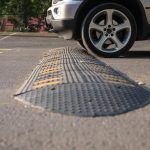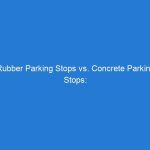Overview
Definition of Speed Ramps and Speed Bumps
Speed ramps and speed bumps are traffic calming devices designed to reduce vehicle speeds in residential areas, parking lots, and other areas with heavy pedestrian traffic. Speed ramps are gradual inclines that force drivers to slow down as they ascend and descend. They are typically longer and less steep than speed bumps. Speed bumps, on the other hand, are shorter and steeper raised sections of road that cause vehicles to slow down abruptly. Both speed ramps and speed bumps are effective in slowing down vehicles and improving safety, but they have different characteristics and are suitable for different situations.
Importance of Traffic Calming
Traffic calming is an essential aspect of urban planning and road safety. It aims to reduce the speed of vehicles and create a safer environment for pedestrians and cyclists. Speed ramps and speed bumps are two common traffic calming solutions that can effectively slow down vehicles in residential areas, school zones, and busy streets. By implementing these measures, communities can mitigate the risks of accidents and improve overall road safety. Additionally, traffic calming measures can help reduce noise pollution and enhance the quality of life for residents. It is crucial for city planners and policymakers to carefully consider the pros and cons of speed ramps and speed bumps to choose the most suitable traffic calming solution for their specific needs.
Purpose of the Article
The purpose of this article is to explore the pros and cons of speed ramps and speed bumps as traffic calming solutions. By examining the advantages and disadvantages of each option, readers will be able to make an informed decision when choosing the right traffic calming solution for their specific needs. This article aims to provide a comprehensive analysis of the benefits and drawbacks of speed ramps and speed bumps, helping readers understand the implications of each option on safety, vehicle speed, and overall traffic flow.
Pros of Speed Ramps
Effective Speed Reduction
Speed ramps and speed bumps are both effective solutions for reducing speed on roads. Speed ramps are gradual inclines that force drivers to slow down as they ascend and descend. They are particularly effective in residential areas and school zones, as they provide a gentle reminder to drivers to reduce their speed. On the other hand, speed bumps are abrupt raised sections of road that require drivers to significantly reduce their speed. They are commonly used in parking lots and areas with high pedestrian traffic. While speed bumps can be more jarring for drivers, they are highly effective at slowing down vehicles. Ultimately, the choice between speed ramps and speed bumps depends on the specific needs of the road and the desired level of speed reduction.
Enhanced Safety for Pedestrians
Speed ramps and speed bumps provide enhanced safety for pedestrians by reducing vehicle speeds in areas with high foot traffic. These traffic calming solutions force drivers to slow down, making it easier for pedestrians to cross the road safely. By implementing speed ramps and speed bumps, the risk of accidents and injuries involving pedestrians is significantly reduced. Additionally, these measures also promote a safer and more walkable environment, encouraging people to choose walking as a mode of transportation.
Minimal Impact on Vehicle Suspension
One of the advantages of speed ramps and speed bumps as traffic calming solutions is their minimal impact on vehicle suspension. Unlike other methods such as potholes or rough road surfaces, speed ramps and bumps are designed to be smooth and gradual, reducing the risk of damage to the suspension system of vehicles. This is particularly beneficial for drivers and their vehicles, as it helps maintain the longevity and performance of the suspension components. Additionally, the minimal impact on vehicle suspension ensures a more comfortable ride for passengers, minimizing discomfort and potential injuries.
Cons of Speed Ramps
Discomfort for Vehicle Occupants
One of the main drawbacks of speed ramps and speed bumps is the discomfort they can cause for vehicle occupants. These traffic calming solutions are designed to slow down vehicles by introducing a sudden change in elevation, which can result in a jarring experience for passengers. The abruptness of the speed ramps and speed bumps can lead to discomfort, especially for individuals with back or neck problems. Additionally, the repeated impact of going over multiple speed ramps or speed bumps can be tiresome and may cause fatigue for long-distance travelers. It is important for road authorities to consider the potential discomfort for vehicle occupants when deciding on the implementation of speed ramps and speed bumps as traffic calming measures.
Potential Damage to Vehicles
One potential drawback of speed ramps and speed bumps is the potential damage they can cause to vehicles. The abrupt change in elevation can lead to scraping or bottoming out of vehicles with low ground clearance. This can result in damage to the undercarriage, exhaust system, and suspension components. Additionally, repeated impact with speed ramps and speed bumps can cause wear and tear on tires and wheels, leading to increased maintenance costs. It is important for drivers to approach these traffic calming measures with caution to minimize the risk of vehicle damage.
Limited Applicability in High-Traffic Areas
In high-traffic areas, speed ramps and speed bumps may have limited applicability as traffic calming solutions. The constant flow of vehicles can make it difficult for drivers to slow down or navigate over these physical obstacles. Additionally, the presence of speed ramps and bumps in high-traffic areas can cause congestion and delays, especially during peak hours. Therefore, alternative traffic calming measures such as traffic signals, roundabouts, or road narrowing may be more suitable in these situations.
Pros of Speed Bumps
Effective Speed Reduction
Speed ramps and speed bumps are both effective solutions for reducing speed in residential areas. Speed ramps are gentle slopes that gradually slow down vehicles, providing a smoother ride for drivers. They are particularly effective in areas where maintaining a consistent speed is important, such as near schools or hospitals. On the other hand, speed bumps are more abrupt and can cause a sudden jolt to vehicles, forcing drivers to slow down quickly. They are often used in areas where traffic needs to be slowed down significantly, such as in parking lots or busy intersections. Both speed ramps and speed bumps have their advantages and disadvantages, so it is important to consider the specific needs of the area when choosing the right traffic calming solution.
Versatility in Installation
Speed ramps and speed bumps offer a versatile solution for traffic calming measures. They can be installed in various locations, such as residential areas, school zones, and parking lots. The installation process is relatively simple and can be done on different types of road surfaces, including asphalt and concrete. This versatility allows for flexibility in implementing traffic calming measures based on the specific needs of each location. Additionally, speed ramps and speed bumps can be easily removed or adjusted if necessary, providing a convenient solution for temporary traffic calming requirements.
Cost-Effective Solution
When it comes to choosing a traffic calming solution, cost-effectiveness is an important factor to consider. Speed ramps and speed bumps are both popular options, but they differ in terms of cost. Speed ramps are generally more cost-effective as they require less material and labor to install. Additionally, speed ramps have a longer lifespan and lower maintenance costs compared to speed bumps. Therefore, if cost is a priority, opting for speed ramps would be a wise choice.
Cons of Speed Bumps
Disruption to Traffic Flow
One of the main concerns with speed ramps and speed bumps is the disruption they can cause to traffic flow. While these traffic calming solutions are effective in reducing speeding and improving safety, they can also slow down the overall flow of traffic. Vehicles need to slow down significantly when approaching speed ramps or speed bumps, which can lead to congestion, especially during peak hours. This disruption to traffic flow can be inconvenient for drivers and may result in longer travel times. However, it is important to weigh the benefits of improved safety against the potential inconvenience of traffic disruption when considering the use of speed ramps and speed bumps.
Potential Damage to Vehicles
Speed ramps and speed bumps can potentially cause damage to vehicles if not properly designed and maintained. The abrupt changes in elevation can lead to excessive jolts and vibrations, which may result in damage to the suspension system, tires, and other vehicle components. Additionally, vehicles with low ground clearance may scrape against the ramps or bumps, causing further damage. It is important to consider the design specifications, including height, width, and slope, to minimize the risk of vehicle damage. Regular inspections and maintenance of speed ramps and bumps are essential to ensure they remain safe for both vehicles and drivers.
Challenges for Emergency Vehicles
One of the main challenges for emergency vehicles when it comes to speed ramps and speed bumps is the potential delay in response time. These traffic calming solutions are designed to slow down vehicles, which can be beneficial for reducing accidents and improving pedestrian safety. However, for emergency vehicles that need to reach their destination quickly, the presence of speed ramps and speed bumps can hinder their progress. The sudden deceleration and acceleration required to navigate these obstacles can result in delays, especially if the driver is not familiar with the road. Therefore, it is essential for city planners and traffic engineers to carefully consider the placement of speed ramps and speed bumps to ensure that emergency vehicles can navigate the roads efficiently while still maintaining the intended traffic calming effects.
Conclusion
Considerations for Choosing the Right Traffic Calming Solution
When considering the right traffic calming solution, there are several important factors to take into account. First, it is crucial to assess the specific needs and characteristics of the area where the solution will be implemented. Factors such as traffic volume, speed limits, and road conditions should be considered to determine the most effective solution. Additionally, the preferences and concerns of the local community should be taken into consideration. Public opinion and feedback can provide valuable insights into the most suitable option. Furthermore, the cost and maintenance requirements of each solution should be evaluated. Some traffic calming solutions may require more frequent maintenance or have higher installation costs than others. Finally, it is important to consider the long-term effectiveness of the chosen solution. Will it effectively reduce speeds and improve safety over time? These considerations will help in selecting the most appropriate traffic calming solution for a particular area.
Balancing Speed Reduction and Traffic Flow
When considering the implementation of speed ramps or speed bumps as a traffic calming solution, it is crucial to strike a balance between speed reduction and traffic flow. While these traffic calming measures effectively slow down vehicles, they can also disrupt the smooth flow of traffic if not carefully designed and implemented. It is important to consider factors such as the road’s capacity, the volume of traffic, and the desired speed reduction when deciding on the appropriate traffic calming solution. By finding the right balance, communities can ensure safer roads without compromising the efficiency of traffic movement.
Adapting to Specific Road Conditions
When considering traffic calming solutions such as speed ramps and speed bumps, it is important to take into account the specific road conditions. Factors such as the width and curvature of the road, the volume of traffic, and the speed limit all play a role in determining the most suitable option. For narrow and winding roads, speed ramps may be more effective in reducing speed as they provide a gradual incline and decline. On the other hand, speed bumps are better suited for straight roads with higher speed limits, as they create a more abrupt and noticeable jolt. Ultimately, choosing the right traffic calming solution requires a careful assessment of the road conditions to ensure maximum effectiveness and safety.







